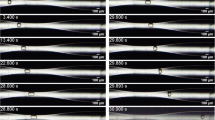Abstract
Microdevices involving a stagnation-point flow, such as cross- and T-junctions, are useful for particle manipulation and characterization. In contrast to the wide use of cross-junctions, T-junctions have received limited attention as a medium for capsule deformation and characterization. In the present study, we investigate computationally the settling shape of an elastic capsule in a T-junction microchannel for a wide range of flow rates. Our work reveals that the capsules show a rich deformation behavior including (inverse) swallow-cap, sit-on and whitewater kayak shapes. We also propose a new methodology for the simultaneous and accurate determination of the shear and area-dilatation moduli of the membrane of artificial capsules via a single experimental technique by utilizing the dependence of the settling capsule’s dimensions on the capillary number and the membrane hardness identified in our investigation. Our moduli methodology utilizes high flow rates (i.e., large capsule deformations) where the effects of the membrane hardness become prominent and thus capsules with different area-dilatation modulus can be identified. Our procedure has the additional advantage of not being influenced by the fluids’ viscosity ratio or the membrane viscosity.









Similar content being viewed by others
References
Abkarian M, Faivre M, Horton R, Smistrup K, Best-Popescu CA, Stone HA (2008) Cellular-scale hydrodynamics. Biomed Mater 3:034011
Alexeev A, Balazs AC (2007) Designing smart systems to selectively entrap and burst microcapsules. Soft Matter 3:1500–1505
Ascoli E, Dandy D, Leal L (1990) Buoyancy-driven motion of a deformable drop toward a planar wall at low Reynolds number. J Fluid Mech 213:287–311
Barthes-Biesel D, Diaz A, Dhenin E (2002) Effect of constitutive laws for two-dimensional membranes on flow-induced capsule deformation. J Fluid Mech 460:211–222
Carin M, Barthès-Biesel D, Edwards-Lévy F, Postel C, Andrei DC (2003) Compression of biocompatible liquid-filled HSA-alginate capsules: determination of the membrane mechanical properties. Biotechnol Bioeng 82:207–212
Chabert M, Viovy J-L (2008) Microfluidic high-throughput encapsulation and hydrodynamic self-sorting of single cells. Proc Natl Acad Sci 105:3191–3196
Chang K, Olbricht W (1993a) Experimental studies of the deformation of a synthetic capsule in extensional flow. J Fluid Mech 250:587–608
Chang K, Olbricht W (1993b) Experimental studies of the deformation and breakup of a synthetic capsule in steady and unsteady simple shear flow. J Fluid Mech 250:609–633
Chen W, Yang Y, Rinadi C, Zhou D, Shen AQ (2009) Formation of supramolecular hydrogel microspheres via microfluidics. Lab Chip 9:2947–2951
de Loubens C, Deschamps J, Boedec G, Leonetti M (2015) Stretching of capsules in an elongation flow, a route to constitutive law. J Fluid Mech 767:R3
Dimitrakopoulos P (2012) Analysis of the variation in the determination of the shear modulus of the erythrocyte membrane: effects of the constitutive law and membrane modeling. Phys Rev E 85:041917
Dimitrakopoulos P (2014) Effects of membrane hardness and scaling analysis for capsules in planar extensional flows. J Fluid Mech 745:487–508
Dimitrakopoulos P, Kuriakose S (2015) Determining a membrane’s shear modulus, independent of its area-dilatation modulus, via capsule flow in a converging micro-capillary. Soft Matter 11:2782–2793
Dodson WR III, Dimitrakopoulos P (2008) Spindles, cusps, and bifurcation for capsules in Stokes flow. Phys Rev Lett 101:208102
Dodson WR, Dimitrakopoulos P (2009) Dynamics of strain-hardening and strain-softening capsules in strong planar extensional flows via an interfacial spectral boundary element algorithm for elastic membranes. J Fluid Mech 641:263–296
Fu T, Ma Y, Funfschilling D, Li HZ (2011) Dynamics of bubble breakup in a microfluidic T-junction divergence. Chem Eng Sci 66:4184–4195
Galindo-Rosales FJ, Alves M, Oliveira M (2013) Microdevices for extensional rheometry of low viscosity elastic liquids: a review. Microfluid Nanofluid 14:1–19
Hu X-Q, Sévénié B, Salsac A-V, Leclerc E, Barthès-Biesel D (2013) Characterizing the membrane properties of capsules flowing in a square-section microfluidic channel: effects of the membrane constitutive law. Phys Rev E 87:063008
Hudson S, Phelan F Jr, Handler M, Cabral J, Migler K, Amis E (2004) Microfluidic analog of the four-roll mill. Appl Phys Lett 85:335–337
Jullien M-C, Ching M-JTM, Cohen C, Menetrier L, Tabeling P (2009) Droplet breakup in microfluidic T-junctions at small capillary numbers. Phys Fluids 21:072001
Koleva I, Rehage H (2012) A comparison of different experimental methods for investigating the mechanical properties of plane polysiloxane membranes and capsule walls. Soft Matter 8:7672–7682
Kuriakose S, Dimitrakopoulos P (2011) Motion of an elastic capsule in a square microfluidic channel. Phys Rev E 84:011906
Leclerc E, Kinoshita H, Fujii T, Barthès-Biesel D (2012) Transient flow of microcapsules through convergent–divergent microchannels. Microfluid Nanofluid 12:761–770
Lee JS, Dylla-Spears R, Teclemariam NP, Muller SJ (2007) Microfluidic four-roll mill for all flow types. Appl Phys Lett 90:074103
Lefebvre Y, Leclerc E, Barthès-Biesel D, Walter J, Edwards-Lévy F (2008) Flow of artificial microcapsules in microfluidic channels: a method for determining the elastic properties of the membrane. Phys Fluids 20:123102
Link D, Anna SL, Weitz D, Stone H (2004) Geometrically mediated breakup of drops in microfluidic devices. Phys Rev Lett 92:054503
Liovic P, Francois M, Rudman M, Manasseh R (2010) Efficient simulation of surface tension-dominated flows through enhanced interface geometry interrogation. J Comput Phys 229:7520–7544
Neubauer MP, Poehlmann M, Fery A (2014) Microcapsule mechanics: from stability to function. Adv Colloid Interface Sci 207:65–80
Park S-Y, Dimitrakopoulos P (2013) Transient dynamics of an elastic capsule in a microfluidic constriction. Soft Matter 9:8844–8855
Pieper G, Rehage H, Barthès-Biesel D (1998) Deformation of a capsule in a spinning drop apparatus. J Colloid Interface Sci 202:293–300
Pozrikidis C (1990) The deformation of a liquid drop moving normal to a plane wall. J Fluid Mech 215:331–363
Pozrikidis C (2003) Modeling and simulation of capsules and biological cells. CRC Press, Boca Raton
Prevot M, Cordeiro AL, Sukhorukov GB, Lvov Y, Besser RS, Möhwald H (2003) Design of a microfluidic system to investigate the mechanical properties of layer-by-layer fabricated capsules. Macromol Mater Eng 288:915–919
Quinn DJ, Pivkin I, Wong SY, Chiam K-H, Dao M, Karniadakis GE, Suresh S (2011) Combined simulation and experimental study of large deformation of red blood cells in microfluidic systems. Ann Biomed Eng 39:1041–1050
Rachik M, Barthes-Biesel D, Carin M, Edwards-Levy F (2006) Identification of the elastic properties of an artificial capsule membrane with the compression test: effect of thickness. J Colloid Interface Sci 301:217–226
Samie M, Salari A, Shafii MB (2013) Breakup of microdroplets in asymmetric T junctions. Phys Rev E 87:053003
Seiffert S, Thiele J, Abate AR, Weitz DA (2010) Smart microgel capsules from macromolecular precursors. J Am Chem Soc 132:6606–6609
Shelby JP, White J, Ganesan K, Rathod PK, Chiu DT (2003) A microfluidic model for single-cell capillary obstruction by Plasmodium falciparum-infected erythrocytes. Proc Natl Acad Sci 100:14618–14622
Skalak R, Tozeren A, Zarda R, Chien S (1973) Strain energy function of red blood cell membranes. Biophys J 13:245
Tanyeri M, Schroeder CM (2013) Manipulation and confinement of single particles using fluid flow. Nano Lett 13:2357–2364
Timoshenko SP, Woinowsky-Krieger S (1959) Theory of plates and shells. McGraw-Hill, London
Wang Y, Dimitrakopoulos P (2006) A three-dimensional spectral boundary element algorithm for interfacial dynamics in Stokes flow. Phys Fluids 18:082106
Zhao C-X (2013) Multiphase flow microfluidics for the production of single or multiple emulsions for drug delivery. Adv Drug Deliv Rev 65:1420–1446
Acknowledgements
This work was supported in part by the National Science Foundation. Most computations were performed on multiprocessor computers provided by the Extreme Science and Engineering Discovery Environment (XSEDE) which is supported by the National Science Foundation.
Author information
Authors and Affiliations
Corresponding author
Rights and permissions
About this article
Cite this article
Koolivand, A., Dimitrakopoulos, P. Deformation of an elastic capsule in a microfluidic T-junction: settling shape and moduli determination. Microfluid Nanofluid 21, 89 (2017). https://doi.org/10.1007/s10404-017-1923-6
Received:
Accepted:
Published:
DOI: https://doi.org/10.1007/s10404-017-1923-6




